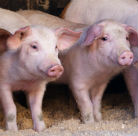Locking down problem feed ingredients
Posted: August 16, 2015 | Written By: Kevin Fischer, Form-A-Feed Swine Nutritional Services

We have had very few challenges to this year’s corn in the upper Midwest. An early spring and timely rains have made this a year for growing corn. However let’s dial the clock back to the 2014 crop year.
A cold, wet spring led to delayed planting in many areas. After the late start, the faucet turned off to the point of drought in some areas. The 2014 crop was under stress for most of the growing season and this crop is what we currently find in most of our mills and feed bins. It is no wonder why the occurrence of feed quality problems has continued to rise through the summer in most of the upper Midwest.
Cold, wet planting conditions are the perfect growing environment for a mold named Fusariam in the soil. When the plant emerges, the mold is transferred to the plant from the soil where it continues to multiply. The by-product of Fusarium growth is mycotoxins. Mycotoxins are a group of diverse fungal metabolites which cause undesirable effects in exposed animals. The effects include premature puberty and swollen vulvas in gilts, tail biting, ear necrosis, vomiting, general poor performance, and even death.
This is primarily a corn problem. When we include distiller’s grains in diets, we magnify the toxins by three times due to the removal of a majority of the starch in corn. What compounds the problem is that the distillation process does not affect toxins. Virtually every acre of corn ground in the upper Midwest has Fusarium mold spores in the ground. This makes this a corn problem and not a feed mill specific problem. The corn may show no sign of mold, but the mycotoxins may still be there.
What can we do about it? Feeding adsorbents like silicates can interfere with mycotoxins by forming a nontoxic compound. Additionally, including an antioxidant in your feed will inhibit and likely kill any remaining live mold in the bin. Also, certain ingredients, such as yeast cell wall compounds, can bio-transform the toxin into a nontoxic form which is virtually harmless.
Form-A-Feed has developed a line of products to combat this problem. This has been an evolution in the company for over 30 years. We have combined the traits of absorbents, antioxidants and yeast cell wall to cover as many bases as possible.
Contact your Form-A-Feed representative for more information.